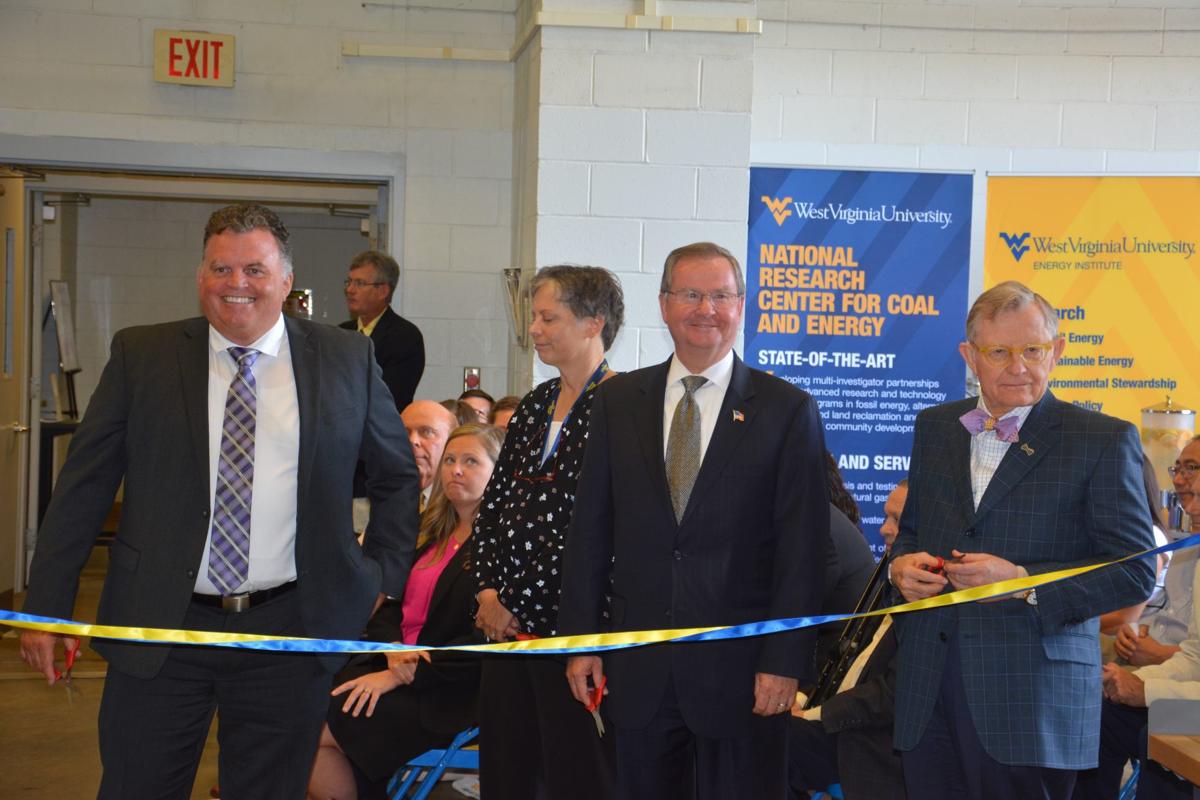Rare Earth Element Extraction Facility Unveiled on WVU's Evansdale Campus

By Conor Griffith
July 19, 2018 - The Mountain State took a step toward the potential creation of a whole new industry Wednesday morning with the ribbon cutting of the new Rare Earth Extraction Facility on the Evansdale Campus of West Virginia University.
Housed within the National Research Center for Coal and Energy, this new complex was the result of collaboration between the university and the U.S. Department of Energy’s National Energy Technology Laboratory. The complex features a new method of harnessing rare earth elements that make cell phones, computers, guidance systems and just about every other piece of modern technology possible.

From left, Rockwell Automation’s Paul McRoberts, U.S. Department of Energy Assistant Secretary for Fossil Energy Steven Winberg and WVU President E. Gordon Gee prepare to cut the ribbon on the new facility.
Photo by Conor Griffith
In this new method, acid mine drainage (also known as sludge) is dissolved in acid, then transferred to glass mixers that make an emulsion that allows an extractant chemical to grab the desired elements from the water while leaving behind other substances such as iron. What’s left is a concentrated rare earth oxide that can be processed into valuable metals.
“That could go a long way toward creating new economic opportunity for West Virginia and the region and make treating acid mine drainage a financial boom instead of a financial burden,” said Brian Anderson, director of the WVU Energy Institute who hosted the ribbon cutting. “Even abandoned coal mines can become a valuable resource. For example, scandium, one of these rare earths, is worth about $4,500 per kilogram as an oxide, the form that it will leave this facility. After refining, it would be worth $15,000 per kilogram.”
By comparison, conventional rare earth element extraction processes tend to produce a lot of waste and can be expensive. Those processes entail mining ore from mineral deposits in rock, which is crushed into a powder, dissolved in powerful chemical solutions and filtered multiple times to retrieve rare earth oxides, which are further processed and refined.
The ultimate goal of this pilot facility is testing the technical and economic feasibility of scaling-up the technology to commercialize this new separation and extraction process.
Among the guests present for the ribbon cutting and subsequent tour was Steven Winberg, the Department of Energy’s assistant secretary for fossil energy.
“It’s a pleasure to be in West Virginia because West Virginians understand what it really means to have an ‘all-of-the-above’ energy strategy,” he said, adding that one of the first projects of his career took place in Marion County’s Rivesville. “A lot of places I go don’t really understand that, and rare earth elements are part of that.”
Winberg said this step forward could have geopolitical implications for West Virginia because now the United States has the ability to generate a supply of these valuable minerals and not be held hostage by other suppliers. He said the government has spent about $75 million on rare earth element research in recent years compared to $140 million developing fracking technology in the 1980s.
“This is a rock solid investment,” he said, adding that acid mine drainage in the Appalachian Basin could yield between 600 and 2,700 tons of rare earth elements per year. The country’s defense industries use about 800 tons per year.
WVU Energy Institute Director Brian Anderson displays a sample of sludge from a mine that can yield valuable rare earth elements.
Photo by Conor Griffith
Rockwell Automation is the private sector partner in this endeavor via the company’s use of their sensor and control technologies. Paul McRoberts, regional industry mining, metals and cement manager at Rockwell Automation, is a 30-year veteran of the industry. Having engaged in projects all over the world, he said this is one of the most exciting projects he’s seen yet.
“Research on rare earth extraction is one of the ways our university, especially in an energy state, is fulfilling its most important mission — which is the land grant mission — and that mission is to advance the prosperity of the people of this state,” WVU President E. Gordon Gee said. “It’s an extraordinary opportunity.”
Provided test runs in the new facility show promise, Anderson said the next step is to apply this method on a large, commercial scale.
Guests take a closer look at the facility’s mechanisms following the ribbon cutting.
Photo by Conor Griffith
The principal investigator of this project was Paul Ziemkiewicz, who is also the director of the WVU Water Research Institute and a specialist on acid mine drainage. He worked with Xingbo Liu, professor of mechanical engineering, and Aaron Noble, associate professor of mining and minerals engineering at Virginia Tech, to design the processing facility from the ground up using advanced separation technologies. It will be operated by Chris Vass, a WVU graduate student and Summersville native.
Ziemkiewicz said that no other facility like this exists in the world, and the acid mine drainage itself helps concentrate the rare earth elements more densely than traces found elsewhere. He added that acid mine drainage is seen as an environmental liability, but it could now lead to new businesses in transporting the material away for processing. This also means that landowners with an abandoned mine on their property could be looking at a new revenue stream.
As for building up a larger commercial entity, he said that might be so complicated considering the facility was designed and built using machinery already commonly used by industry. The proprietary element from WVU and NETL, he said, comes from the knowledge of how to operate it, the right pH levels and automation systems.
CoalZoom.com - Your Foremost Source for Coal News

